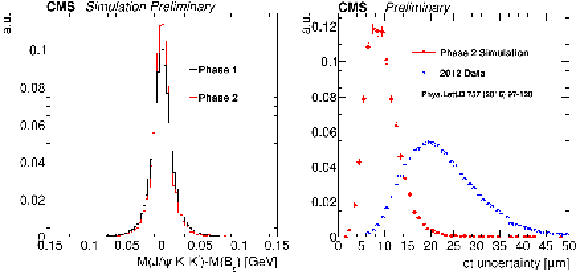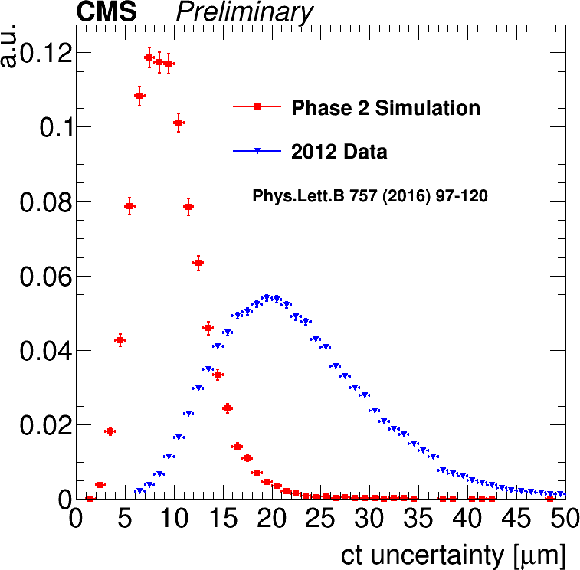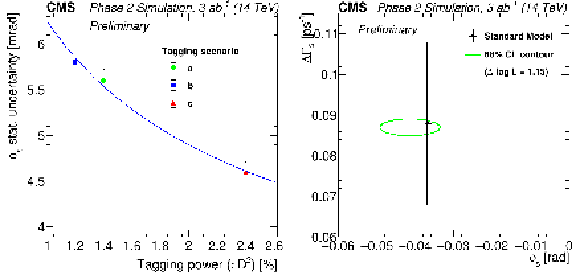

Compact Muon Solenoid
LHC, CERN
| CMS-PAS-FTR-18-041 | ||
| CP-violation studies at the HL-LHC with CMS using $\mathrm{B^0_s}$ decays to $\mathrm{J}/\psi\phi(1020)$ | ||
| CMS Collaboration | ||
| December 2018 | ||
| Abstract: We have estimated the expected sensitivity on the CP-violating phase $\phi_s$ measured in the decay channel $\mathrm{B^0_s} \to \! \mathrm{J}/\psi\phi(1020)$ in pp collisions with the CMS detector at the end of the HL-LHC data-taking with 3 ab$^{-1}$ of collected data. The sensitivity on $\phi_s$ mainly depends on the collected statistics, on the flavour-tagging power, and on the proper-decay-time resolution. The study is performed using fully simulated signal events and toy Monte Carlo experiments, for a few assumed tagging scenarios. The sensitivity on $\phi_s$ is expected to be in the 5-6 mrad range, which improves the current world average uncertainty by a factor of five. | ||
| Links: CDS record (PDF) ; inSPIRE record ; CADI line (restricted) ; | ||
| Figures | |

png pdf |
Figure 1:
Left: invariant mass resolution in the Phase 2 sample compared with Phase 1 case. Right: $c\tau $ uncertainty distribution in 2012 data (blue) and Phase 2 MC (red) samples. The better performance of Phase 2 w.r.t. 2012 data is due to the Phase 2 tracker. |

png |
Figure 1-a:
Left: invariant mass resolution in the Phase 2 sample compared with Phase 1 case. Right: $c\tau $ uncertainty distribution in 2012 data (blue) and Phase 2 MC (red) samples. The better performance of Phase 2 w.r.t. 2012 data is due to the Phase 2 tracker. |

png |
Figure 1-b:
Left: invariant mass resolution in the Phase 2 sample compared with Phase 1 case. Right: $c\tau $ uncertainty distribution in 2012 data (blue) and Phase 2 MC (red) samples. The better performance of Phase 2 w.r.t. 2012 data is due to the Phase 2 tracker. |

png pdf |
Figure 2:
Left: variation of the $\phi _s$ statistical uncertainty as function of the tagging power ($\epsilon D^2$) see equation (1), measured in different flavour tagging scenarios. A function proportional to $1/\sqrt {\epsilon D^2}$ is shown to describe the behaviour of the $\phi _s$ uncertainty in the selected range. Right: 68% confidence level (CL) contour from the fit of a toy MC pseudo-experiment generated in the tagging scenario $c$. The contour combines statistical and systematic uncertainties. The black cross represents the SM expectations [2][1]. |

png |
Figure 2-a:
Left: variation of the $\phi _s$ statistical uncertainty as function of the tagging power ($\epsilon D^2$) see equation (1), measured in different flavour tagging scenarios. A function proportional to $1/\sqrt {\epsilon D^2}$ is shown to describe the behaviour of the $\phi _s$ uncertainty in the selected range. Right: 68% confidence level (CL) contour from the fit of a toy MC pseudo-experiment generated in the tagging scenario $c$. The contour combines statistical and systematic uncertainties. The black cross represents the SM expectations [2][1]. |

png |
Figure 2-b:
Left: variation of the $\phi _s$ statistical uncertainty as function of the tagging power ($\epsilon D^2$) see equation (1), measured in different flavour tagging scenarios. A function proportional to $1/\sqrt {\epsilon D^2}$ is shown to describe the behaviour of the $\phi _s$ uncertainty in the selected range. Right: 68% confidence level (CL) contour from the fit of a toy MC pseudo-experiment generated in the tagging scenario $c$. The contour combines statistical and systematic uncertainties. The black cross represents the SM expectations [2][1]. |
| Tables | |

png pdf |
Table 1:
Statistical uncertainty of $\phi _s$ obtained from toy MC pseudo-experiments for different scenarios of flavour tagging. |
| Summary |
| The CMS sensitivity for the measurement of the CP-violating phase $\phi_s$ in the HL-LHC era has been estimated using simulated data and MC toy pseudo-experiments corresponding to the 3 ab$^{-1}$ of integrated luminosity. The offline selection of signal events and the analysis strategy are similar to what was used in the past except for the tagging performance, for which three different scenarios have been considered. Assuming the new tagging power ($\epsilon D^2$) to be in the range 1.2-2.4%, and a total of 9 million $\mathrm{B^0_s}$ candidates, we expect the $\phi_s$ statistical uncertainty to be 5-6 mrad at the end of Phase 2 data taking, which improves the current world average uncertainty by a factor of five. |
| References | ||||
| 1 | CKMfitter Group Collaboration | CP violation and the CKM matrix: Assessing the impact of the asymmetric $ B $ factories | EPJC41 (2005), no. 1, 1--131 | hep-ph/0406184 |
| 2 | M. Artuso, G. Borissov, and A. Lenz | CP violation in the $ B_s^0 $ system | Rev. Mod. Phys. 88 (2016), no. 4, 045002 | 1511.09466 |
| 3 | HFLAV Collaboration | Averages of $ b $-hadron, $ c $-hadron, and $ \tau $-lepton properties as of summer 2016 | EPJC77 (2017), no. 12, 895 | 1612.07233 |
| 4 | CMS Collaboration | Measurement of the CP-violating weak phase $ \phi_{s} $ and the decay width difference $ \Delta \Gamma_{\mathrm{s}} $ using the $ \mathrm{B^0_s} \to \mathrm{J} / \psi \phi(1020) $ decay channel in pp collisions at $ \sqrt{s} = $ 8 TeV | PLB 757 (2015) 97--120 | |
| 5 | LHCb Collaboration | Physics case for an LHCb Upgrade II - Opportunities in flavour physics, and beyond, in the HL-LHC era | 1808.08865 | |
| 6 | CMS Collaboration | The CMS Experiment at the CERN LHC | JINST 3 (2008) S08004 | CMS-00-001 |
| 7 | CMS Collaboration | Technical Proposal for the Phase-II Upgrade of the CMS Detector | CMS-PAS-TDR-15-002 | CMS-PAS-TDR-15-002 |
| 8 | CMS Collaboration | The Phase-2 Upgrade of the CMS Tracker | CDS | |
| 9 | CMS Collaboration | The Phase-2 Upgrade of the CMS Barrel Calorimeters Technical Design Report | CDS | |
| 10 | CMS Collaboration | The Phase-2 Upgrade of the CMS Endcap Calorimeter | CDS | |
| 11 | CMS Collaboration | The Phase-2 Upgrade of the CMS Muon Detectors | CDS | |
| 12 | CMS Collaboration | Expected performance of the physics objects with the upgraded CMS detector at the HL-LHC | ||
| 13 | CMS Collaboration | The Phase-2 Upgrade of the CMS Tracker | CDS | |
| 14 | H. G. Moser and A. Roussarie | Mathematical methods for B0 anti-B0 oscillation analyses | NIMA384 (1997) 491--505 | |
| 15 | LHCb Collaboration | Opposite-side flavour tagging of B mesons at the LHCb experiment | EPJC72 (2012) 2022 | 1202.4979 |

|
Compact Muon Solenoid LHC, CERN |

|

|

|

|

|

|